Equipment Reviews
Solarscope SF70 h-alpha filter
- Details
- Written by: Jeff Young
- Parent Category: Astronomy
- Hits: 3659
Background
For years I’ve been primarily a deep-sky observer, with a recent interest in at-the-eyepiece sketching. My primary instruments include a 16” APM Mak-Cass and 4” Takahashi FC-100, mounted on an Astro-Physics 1200GTO GEM. They are housed in a domed observatory I built in my garden some 3 or 4 years ago. Solar h-alpha viewing had always intrigued me (particularly during the summers when it never gets truly dark at 54°N), and so when the opportunity came to take a double-stacked Coronado SolarMax 40 back in part-trade on another scope I was selling, I took it.
It didn’t take long to discover the thrill of solar h-alpha viewing, or to get hooked on sketching prominences. While some of my early efforts were pretty bad, my technique progressed rapidly and I soon found myself wanting a bit more magnification, and the comfort of a binoviewer. (Solar viewing, like planetary, benefits greatly from extended study to catch the fleeting moments of better-than-average seeing. I find this much more comfortable when not having to exclude the signal from one eye.)
The little SolarMax 40 DS simply didn’t have the aperture to deliver these two goals. In my experience it tops out at about 75X in mono; while single-stacking it would probably gain enough light to add a bino, the resolution limit of the aperture would still limit useful magnification to around 75X. So the search was on for more aperture (a search I’ll well-familiar with from my deep-sky pursuits).
The remainder of this review will make more sense if one understands my particular psychology. I’m a perfectionist and a fit-and-finish nut. I like things that exude quality. Regardless of whether or not said quality makes any real difference in use, it will make a difference in my enjoyment of the item. I searched for quite some time for a Takahashi FC-100 because the newer FS-102 has a decal on the dewshield instead of the older FC-100’s painted logo.
I won’t go into the details that led me to select the Solarscope SF70. Some of them were a function of timing (Coronado’s factory move, Lunt’s start-up phase), and some of them were only unvalidated gut feelings (my wife’s admonition to get something that ”you know will meet your expectations. I don’t want to listen to you complaining if it doesn’t”).
Delivery
I ordered through VentureScope in the UK and was quoted a 2 to 3 week delivery time. The filter arrived in just over two weeks. The case is your standard blow-moulded plastic, but is highlighted by a nice silk-screen logo on the front (no decals here).
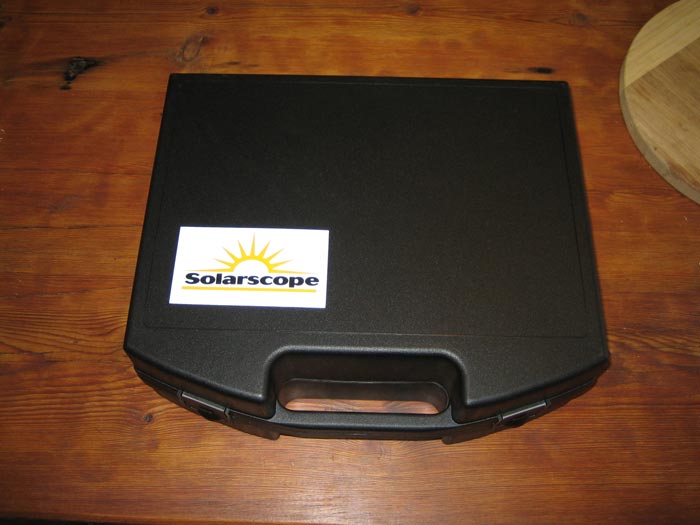
Inside the etalon, adapter ring, blocking filter and 2” to 1.25” step-down adapter are nicely housed in die-cut foam.
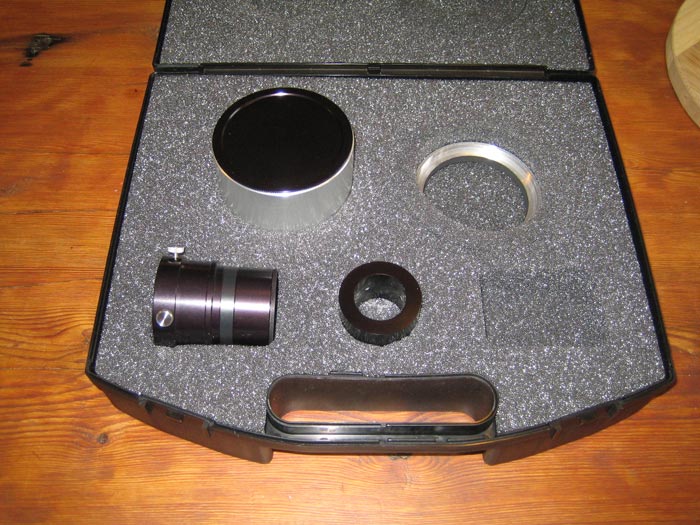
Both the etalon and blocking filter have nice machined aluminium covers on both sides.
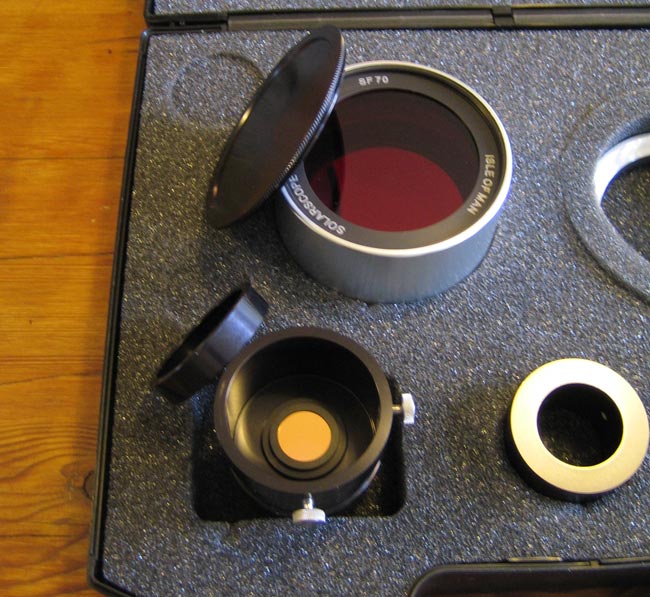
While the blocking filter housing does not have a compression ring, the thumbscrews do contain nylon inserts (or some other soft material) in their ends which nicely protect your diagonal, Barlow, or what-have-you.
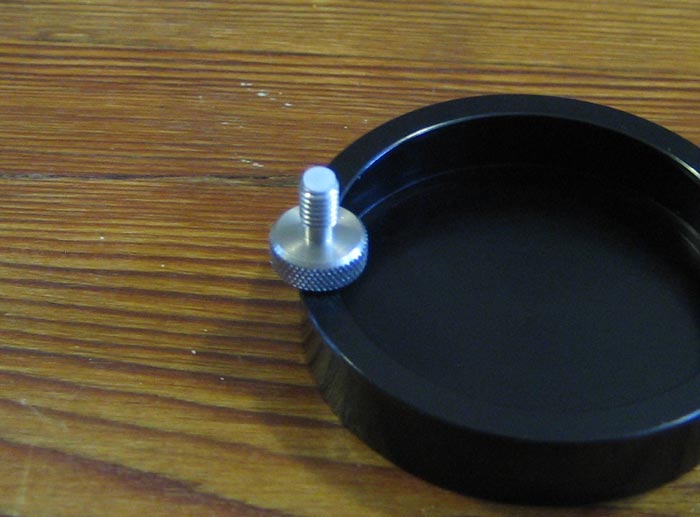
This view of the objective-facing end of the blocking filter shows the exemplary machining employed throughout.
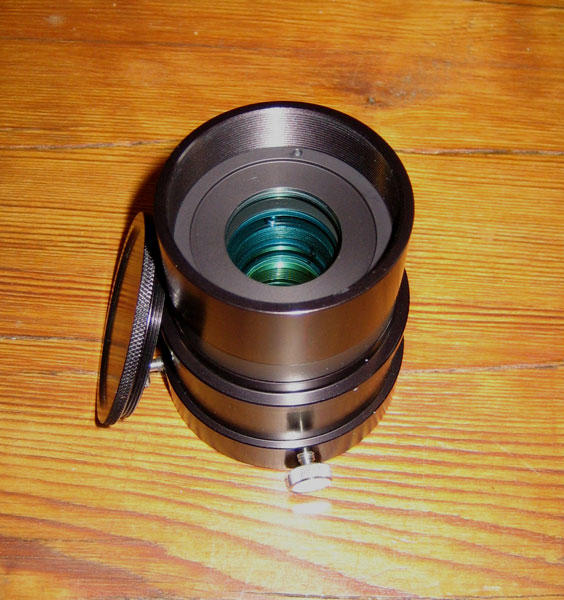
The filter also comes with a glossy brochure containing instructions, safety advice, and a bit of information about Solarscope’s other products. It’s considerably nicer than the photocopied sheet that came with my SolarMax, but then my SolarMax is a very early one and may not reflect Meade/Coronado’s current delivery.
Accessorizing
It seems a bit of a stretch to consider a telescope an “accessory” for a filter, but if you compare the costs it does work out that way. Because h-alpha viewing is done on a single wavelength, whether or not the telescope can focus widely different wavelengths at the same point is immaterial. Control of spherical aberration and scatter are still important, however, and these are often better handled in higher-quality instruments. Since high-end achromats are few and far between, I focused on last-generation apochromats and semi-apochromats.
As mentioned earlier, I also have a thing about how the end-product looks. A filter which is smaller than the dew shield behind it just doesn’t cut it for me. (I guess that makes me a classicist as well as a perfectionist?) I also didn’t like any of the setups which attach the filter to a sliding dewshield. My research indicated the Tele Vue’s Pronto fit the bill perfectly: a 70mm f/6.8 doublet with a nice focuser and a threaded lens-cell, but at a fraction of the cost of their current TV76 APOs. The SF70 filter’s adapter ring screws directly into the lens-cell, and the filter is the same outside diameter as the dew shield. All-in-all it makes for a very neat and tidy setup.
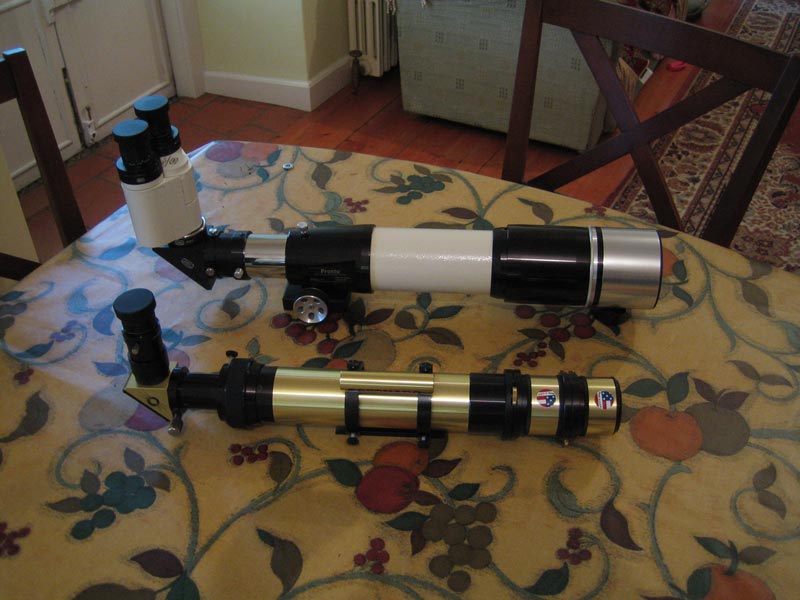
Since I do a lot of sketching, I prefer a tracking mount. GoTo, on the other hand, is a bit unnecessary as there’s only one target for this rig, and even in Ireland it’s usually pretty easy to find. I was therefore looking at some of the more “classic” mounts. The Takahashi Sky Patrol looked like it might be a bit light if I ever double-stacked, while their P2Z appeared to fit the bill perfectly. I own several Astro-Physics mounts so they were also considered, although even the smallest AP400 is a bit bigger than I needed. Sadly, P2Z’s don’t come up for sale often. Happily, I did manage to quickly find a good deal on an AP400 QMD.
The customary method of mounting a Tele Vue clamshell on a GEM is to put a dovetail on the bottom of the clamshell and then a dovetail saddle on the GEM. One of the primary purposes of a standard dovetail and saddle is to allow fore/aft balancing – something a clamshell already does. The customary method therefore seems to me to be added bulk and weight over what is needed. I machined up a custom fixed adapter plate, and a couple of shoulder bolts to make the clamshell a no-tools affair.
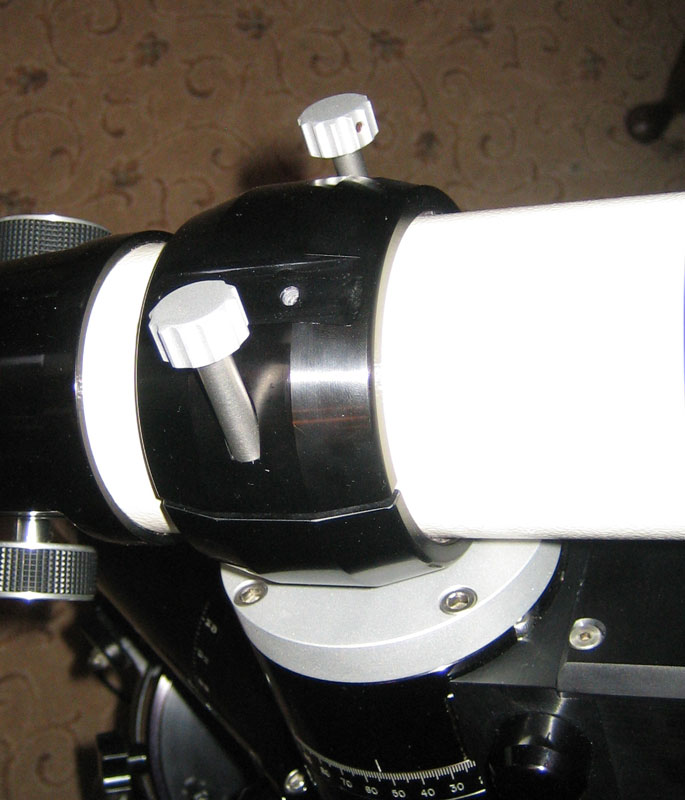
The end result made for a fairly neat-and-tidy solar h-alpha setup.
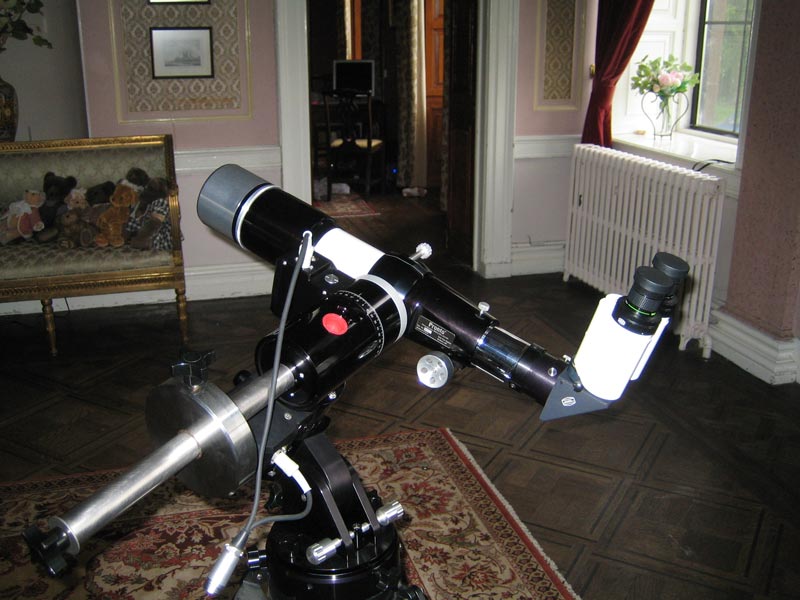
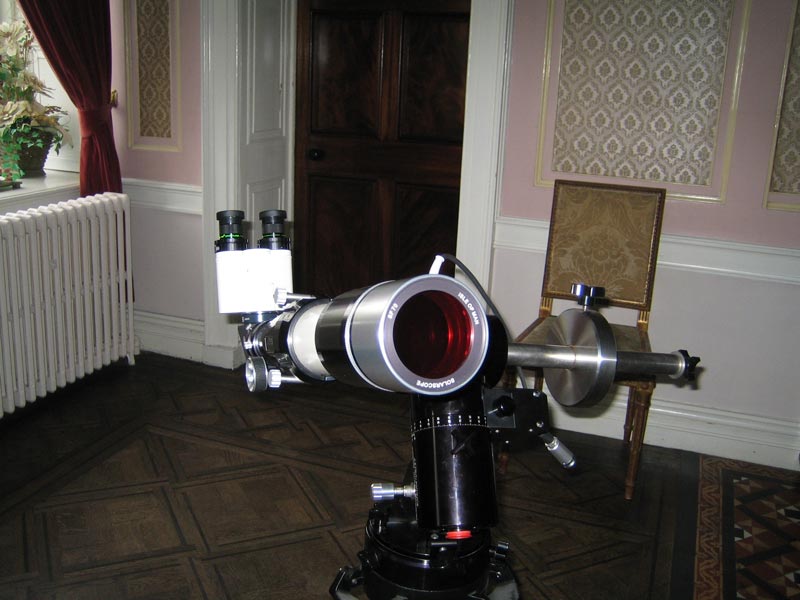
A quick word about focus. I’m using the Zeiss/Baader MkV binoviewer with the T2 diagonal. (My particular setup uses the Maxbright mirror in the diagonal; the T2 prism has an optical path length some 1 or 2 mm shorter.) This setup comes to focus in the Pronto with the 1.7X glasspath compensator, but you’ll need mighty short oculars to achieve decent magnification with that setup.
It also comes to focus with the Astro-Physics BARCON in these configurations:
· BARCON element screwed directly into T2 diagonal body. Total magnification (including 1.7X glasspath) about 2.8X.
· BARCON element screwed into 2” T2 nosepiece and then inserted into BARCON tube. Total magnification about 3.2X.
· 2” T2 nosepiece inserted into BARCON tube with BARCON element screwed into tube. Total magnification about 4X.
Under the Sun
Many of these comments will compare the SF70/Pronto/BaaderMkV to the SolarMax40DS. This isn’t to suggest that these are competitors in the market; they’re just what I have experience with.
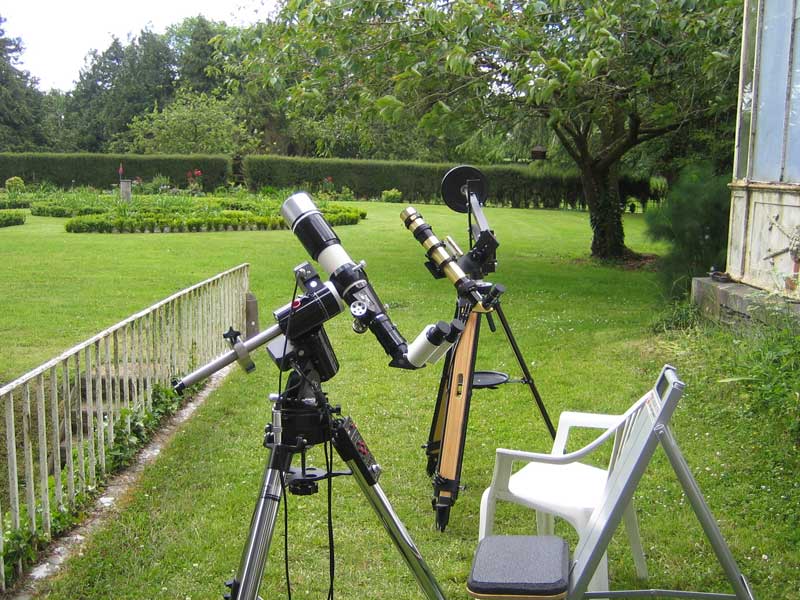
First light with the SF70 occurred at 8:25 AM under fairly good seeing. I was immediately struck by the view of the chromosphere – you could actually see the cross-section of it with a dark band running between the chromosphere and the sun’s disk. The outer surface of the chromosphere was also considerably more “spiky” than I was used to – not just where there were prominences but pretty much all the way around.
I also found the image scale to be much improved – an impression which turned out to be an illusion. After measuring the field I found that with the 20mm Plossls in the 3.2X BARCON configuration (see above) I was getting 75X – exactly what I’m used to using in mono-mode with the SolarMax40DS. It’s possible that the increased image brightness contributes to the impression of a larger image scale, but I put this difference down mostly to the difference between mono- and bino-viewing.
(Note: I’ve since switched to the 4X BARCON configuration. The 15mm Plossls are as short as I can go eye-relief-wise, and at 4X I get 75X, 95X and 125X with the 25mm, 20mm and 15mm Plossls.)
Image Brightness and Detail
Doing a more detailed comparison, I discovered a considerable difference in brightness and detail available. The SF70+bino is much brighter than the double-stacked SolarMax40 in mono. Put a different way, the brightness of prominences in the SF70+bino without a hood is about the same as in the double-stacked SolarMax40 with a black fleece hood over my head.
The SF70+bino can, of course achieve higher magnification. At 125X, the SF70+bino still shows a brighter image than the double-stacked SolarMax40 at 75X. How much brighter is hard to quantify. It’s immediately noticeable, and some of the dimmer prominences displayed greater extent.
It would also be instructive to know if the SF70 maintained the same advantage with the SolarMax40 single-stacked, but as I write this the rain is keeping Ireland green, so who knows?
Here’s a pair of sketches done at 100X (SF70) and 75X (SolarMax40) which show some of the detail and brightness differences.
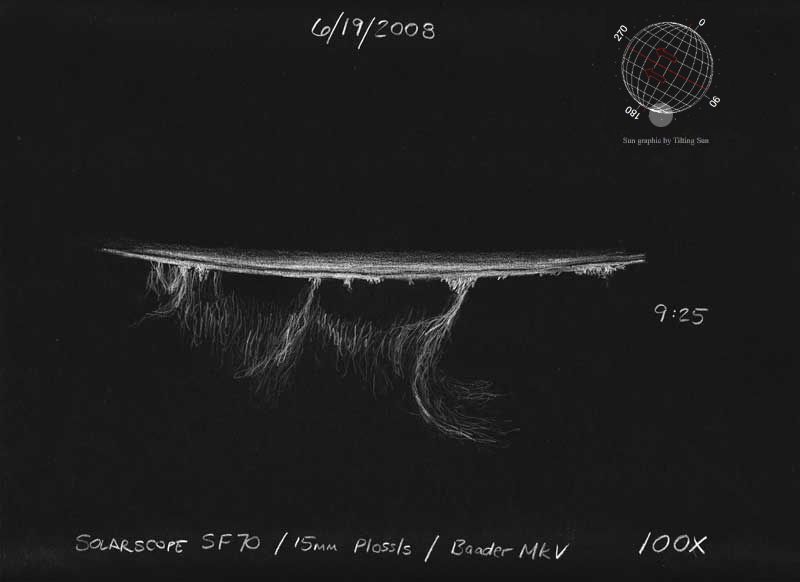
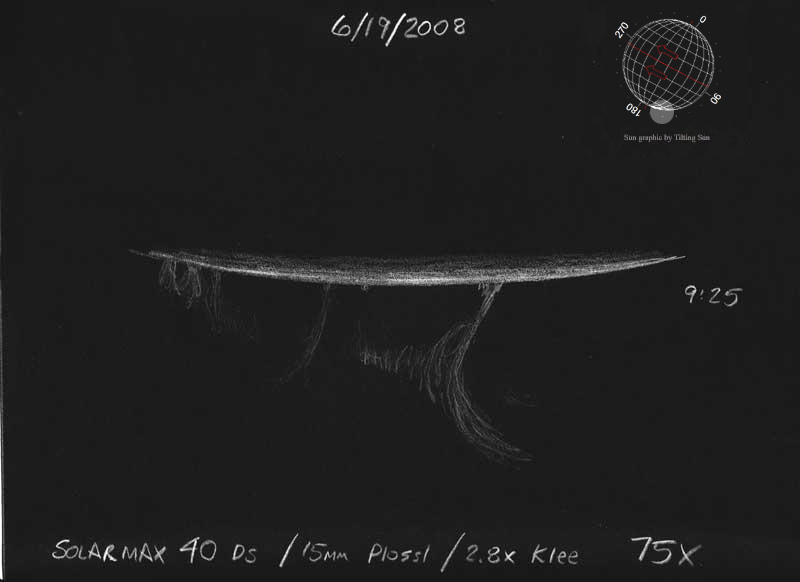
Note in particular the differences in extent, the lack of a chromosphere/disk line, and the reduced detail in the surface of the chromosphere in the SolarMax sketch.
Seeing and Aperture
On 9 days out of 10 I’d use the SolarMax40 at 75X. Crawling would be visible on the limb in about 6 out of 10, and the details would be ever-so-slightly mush on perhaps 3 of them, but not enough to warrant dropping down to 56X.
70mm of aperture makes the seeing much more apparent. I don’t have many days to compare yet, so I can’t give the same relative frequencies, but I can often see waves across the sun’s surface or limb that aren’t visible in the SolarMax. On the other hand, so far the SF70 has always supported a crisp 75X, even when the SolarMax was a little bit mushy. I’ve gotten crisp views at 95/100X most mornings, but only about ½ the time in the afternoon. I’ve had less luck with 125X: some mornings, no afternoons.
Here’s a sketch I got one morning at 125X. There’s so much detail that I found myself barely able to record it all before it had changed. (In fact, I’m not sure a 100mm filter would be useful to a sketcher for this reason – but I’m willing to give it a try if anyone wants to send one my way.)
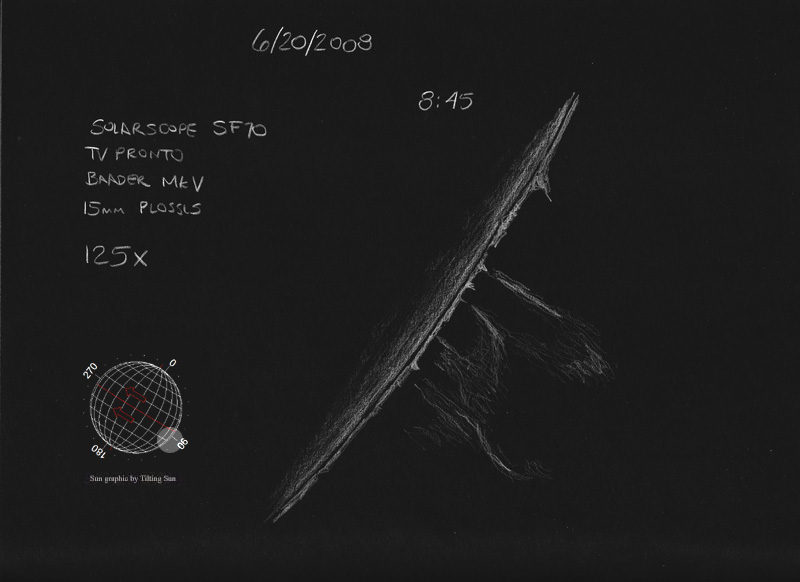
Conclusions
I love this filter. I’d sooner go back to slicing my own bread than give it up. I’d rather have to catch my own mice than do without it. I’d rather… well, you get the idea.
The TV Pronto makes an excellent companion for it. In my configuration the focuser is in front of all the Barlows, so it’s focusing an f/6.8 light cone instead of the resulting f/27 light cone. So I need some sort of fine-focus arrangement. (Pity they stopped selling the Tele Vue Focus Lever. It looks perfect.)
The blocking filter and Barlow also move the diagonal and eyepieces quite far from the front of the scope. I can just reach the tilt-adjusting wheel on the back of the filter, but it’s not as easy as with the SolarMax40. The wheel is much smaller and stiffer though, which results in fewer opportunities for it to get out of adjustment.
It’s hard to tell which results were due to the larger aperture, which to the lack of a central obstruction, and which a combination of both. I’d love to have the opportunity to compare a Solarscope SF60 to a Coronado SM60, or the SF70 to an SM90. Perhaps someday.



